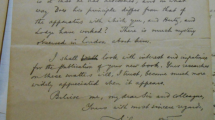Abstract
The 1909 Nobel Prize in Physics was shared between Guglielmo Marconi and Karl Ferdinand Braun for their contribution to the development of wireless telegraphy. The former, Italian-born but living mostly in England, was one of the most famous inventors of his time; the latter was a German physicist almost unknown beyond national borders. The members of the Swedish Royal Academy of Sciences decided to divide the Nobel Prize between these two men, but the choice may have been conditioned by external factors, and not limited to merely scientific merit.

Courtesy of Archivio Fondazione Guglielmo Marconi; http://www.fgm.it

Courtesy of Archivio Fondazione Guglielmo Marconi; http://www.fgm.it
Similar content being viewed by others
Notes
For more about the Nobel nominations and voting system, see [8].
The coherer, a device to detect only the presence of a carrier frequency.
References
Chiaberge, R.: Wireless: Scienza, amori e avventure di Guglielmo Marconi. Garzanti, Milano (2013)
Hildebrand, H.: Nobel prize in physics 1909—presentation speech. Nobelprize.org.Nobel Media AB 2014. http://www.nobelprize.org/nobel_prizes/physics/laureates/1909/press.html. Web. Accessed 4 Jul 2017
Marconi, D.: My Father, Marconi. Mc-Graw Hill, New York (1962)
Marconi, G.: Nobel lecture: wireless telegraphic communication. Nobelprize.org. Nobel Media AB 2014. Web. http://www.nobelprize.org/nobel_prizes/physics/laureates/1909/marconi-lecture.html. Accessed 4 Jul 2017
Masini, G.: Guglielmo Marconi. UTET, Torino (1975)
Slaby, A.: The new telegraphy. recent experiments in telegraphy with sparks. The Century Magazine, April, pp 867–874 (1898)
Solari, L.: Guglielmo Marconi. Odoya, Bologna (2011)
Valotti, B., Delle Donne, G.: Marconi, il ragazzo del wireless. Hoepli, Milano (2015)
Vyvyan, R.N.: Wireless over thirty years. Routledge, London (1933)
Author information
Authors and Affiliations
Corresponding author
Appendix
Appendix
Karl Ferdinand Braun was born in Fulda, Germany, on 6 June 1850. He studied at the University of Marburg and the University of Berlin, where he graduated in 1872. In 1895 he became professor and director of the Institute of Physics in Strasbourg, where he carried out important research on cathode rays. He invented the first cathode-ray oscilloscope, which then became known as “Braun tube” (an essential component for the construction of television sets starting in the 1930s). His most important work was in the field of electricity: for instance, his studies on deviations from Ohm’s law. He worked in acoustics and thermodynamics, and wrote several memoirs on the electromagnetic theory of light. Starting in 1898 he devoted himself to wireless telegraphy (initially through water), creating the Braun-Siemens system, which later merged with the Slaby-Arco system, until the creation of the Telefunken company. Braun’s papers on wireless telegraphy were published in 1901 under the title Drahtlose Telegraphie durch Wasser und Luft (“Wireless telegraphy through water and air”). Braun died in the USA on 20 April 1918.
Guglielmo Marconi (Fig. 2) was born in Bologna on 25 April 1874, the son of Giuseppe Marconi, a landowner, and Annie Jameson, an Irish woman, granddaughter of the founder of the historic distillery John Jameson and Son. He did not receive a traditional education and never graduated, but his curiosity about electrical phenomena led him to frequent contacts with high school teacher Vincenzo Rosa and with Augusto Righi, professor of physics at the University of Bologna. Starting in 1895 he began to devote himself, as a self-taught man, to the first experiments of transmission of Morse signals using electromagnetic waves, using the loft of Villa Griffone, near Bologna, as a laboratory and his butler Mignani as his assistant. He founded his first company in England in 1897 and became famous all around the world after December 1901, when he succeeded in transmitting a telegraphic signal at a distance of 3000 km, across the Atlantic Ocean. Such an achievement was considered impossible by the greatest physicists of the time, who believed that the electromagnetic waves propagated in a straight line (on the contrary, the experiment was successful thanks to the presence of the ionosphere, which allows electromagnetic waves to be reflected on Earth, thus following its curvature, a phenomenon unknown to both Marconi and his contemporaries). Although the use of wireless transmission was strongly opposed by the companies that manufactured telegraph cables, it became an increasingly common practice and this considerably increased the value of the company founded by Marconi, which initially had a monopoly on its use. Marconi’s fame grew further following the rescue at open sea of many ships (including RMS Republic in 1909 and RMS Titanic in 1912) thanks to the presence of a radio operator on board. Since 1919 Marconi continued his research in the field of short waves, using his yacht Elettra as a floating laboratory. He died in Rome on 20 July 1937.
Rights and permissions
About this article
Cite this article
Bischi, M. Who was Karl Ferdinand Braun?. Lett Mat Int 5, 253–259 (2017). https://doi.org/10.1007/s40329-017-0191-3
Published:
Issue Date:
DOI: https://doi.org/10.1007/s40329-017-0191-3




